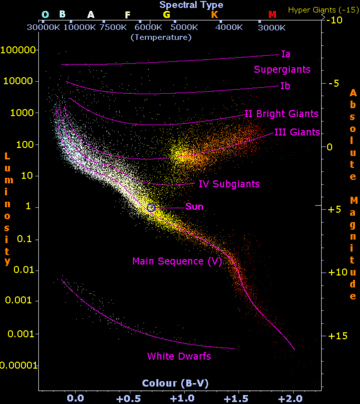Stars spend about 90% of their lifetime fusing hydrogen to produce helium in high-temperature and high-pressure reactions near the core. Such stars are said to be on the main sequence and are called dwarf stars. Starting at zero-age main sequence, the proportion of helium in a star's core will steadily increase. As a consequence, in order to maintain the required rate of nuclear fusion at the core, the star will slowly increase in temperature and luminosity[49]–the Sun, for example, is estimated to have increased in luminosity by about 40% since it reached the main sequence 4.6 billion years ago.[50]
Every star generates a stellar wind of particles that causes a continual outflow of gas into space. For most stars, the amount of mass lost is negligible. The Sun loses 10−14 solar masses every year,[51] or about 0.01% of its total mass over its entire lifespan. However very massive stars can lose 10−7 to 10−5 solar masses each year, significantly affecting their evolution.[52] Stars that begin with more than 50 solar masses can lose over half their total mass while they remain on the main sequence.[53]

The duration that a star spends on the main sequence depends primarily on the amount of fuel it has to fuse and the rate at which it fuses that fuel, i.e. its initial mass and its luminosity. For the Sun, this is estimated to be about 1010 years. Large stars consume their fuel very rapidly and are short-lived. Small stars (called red dwarfs) consume their fuel very slowly and last tens to hundreds of billions of years. At the end of their lives, they simply become dimmer and dimmer.[2] However, since the lifespan of such stars is greater than the current age of the universe (13.7 billion years), no red dwarfs are expected to have yet reached this state.
Besides mass, the portion of elements heavier than helium can play a significant role in the evolution of stars. In astronomy all elements heavier than helium are considered a "metal", and the chemical concentration of these elements is called the metallicity. The metallicity can influence the duration that a star will burn its fuel, control the formation of magnetic fields[54] and modify the strength of the stellar wind.[55] Older, population II stars have substantially less metallicity than the younger, population I stars due to the composition of the molecular clouds from which they formed. (Over time these clouds become increasingly enriched in heavier elements as older stars die and shed portions of their atmospheres.)



0 comments:
Post a Comment